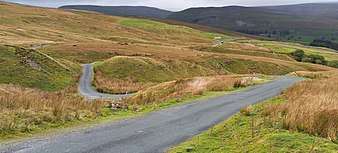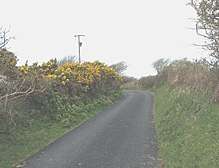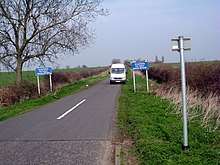Backroad

A backroad is a secondary type of road, usually found in rural areas.
In North Carolina, where they are also referred to as "blue roads", the roads are often constructed of gravel, and are one or two-laned roads off larger roads such as parkways.[1]
In Vermont, the Natural Resources Conservation Service has established a Better Backroads program to help towns and organizations deal with road-related soil erosion problems through grants. Both paved and unpaved backroads are eligible for these grants, which seek to protect water quality from sediment accumulation caused by road and ditch erosion.[2]
Many back-roads in North Carolina were created when the states rural transportation system began investing for factories to located outside of urban areas and into rural areas. This created a system of back-roads that allowed for factories to disperse away from busy urban areas. This was done in the late 1940's under Governor Kerr Scott where investment began and was known as the states rural farm-to-market road system. The idea for the farm-to-market road system was to connect farms out in rural areas to the markets in which they sold there produce, this would allow for easy transportation for those who transported there goods to market places. Ultimately these types of roads became state highways or nice quality roads however, the importance of there beginnings is that they began as rural back-roads for agricultural purposes.[3]
Backroad Safety
Back roads, sometimes called rural roads are known to be unsafe. Back-roads usually have a fatality rate of about two and a half times more than any other road in the United States. A study done in 2015 by TRIP a National Transportation Research Group found that back-roads have a traffic fatality rate of 2.18 deaths per 100 million vehicle miles traveled, whereas all roads combined in the United States have a traffic fatality rate of 0.38 deaths per 100 million vehicle miles traveled. Back-roads contribute to 22% of total amount of vehicle miles traveled in the United States, but make up 43% (15,132) of the total amount of vehicle collisions in 2015 (35,092). In 2015 Texas had the highest number of rural non interstate traffic deaths at 1,259 and California in second with 1,219 deaths[4]. Back roads are known to have features that make them less safe then a highway, some of the features that are seen in back-roads are narrow lanes, limited shoulders, sharp curves, pavement drop offs, steep slopes, and limited clear zones along roadsides. Given that the majority of back roads were built early in american history, they were often designed with different widths and height restrictions, this makes for unsafe road conditions for modern vehicles and trucks[5].
Examples of Backroads


See also
References
- ↑ Sheila Turnage and Jim Hargan, Compass American Guides North Carolina', (Edition 5, Random House, 2009) ISBN 1-4000-0904-9, ISBN 978-1-4000-0904-6, p. 273, found at Google Books. Accessed February 15, 2010.
- ↑ Vermont NRCS. "Better Back Roads". Official website. United States Department of Agriculture. Archived from the original on 4 March 2010. Retrieved 17 February 2010.
- ↑ Greene, Tyler Gray (2018-05-07). "Farm to Factory: Secondary Road Building and the Rural Industrial Geography of Post–World War II North Carolina". Journal of Southern History. 84 (2): 277–310. doi:10.1353/soh.2018.0086. ISSN 2325-6893.
- ↑ "TRIP". www.tripnet.org. Retrieved 2018-06-03.
- ↑ "TRIP". www.tripnet.org. Retrieved 2018-06-03.